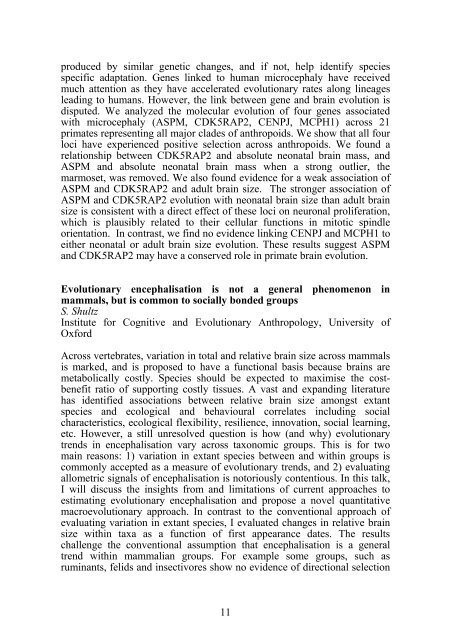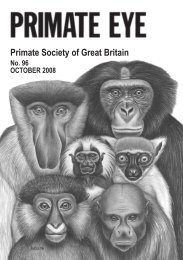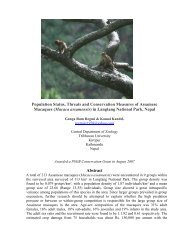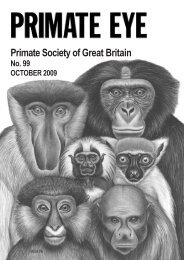2010 Vol 101.pdf (1.63mb) - Primate Society of Great Britain
2010 Vol 101.pdf (1.63mb) - Primate Society of Great Britain
2010 Vol 101.pdf (1.63mb) - Primate Society of Great Britain
You also want an ePaper? Increase the reach of your titles
YUMPU automatically turns print PDFs into web optimized ePapers that Google loves.
produced by similar genetic changes, and if not, help identify species<br />
specific adaptation. Genes linked to human microcephaly have received<br />
much attention as they have accelerated evolutionary rates along lineages<br />
leading to humans. However, the link between gene and brain evolution is<br />
disputed. We analyzed the molecular evolution <strong>of</strong> four genes associated<br />
with microcephaly (ASPM, CDK5RAP2, CENPJ, MCPH1) across 21<br />
primates representing all major clades <strong>of</strong> anthropoids. We show that all four<br />
loci have experienced positive selection across anthropoids. We found a<br />
relationship between CDK5RAP2 and absolute neonatal brain mass, and<br />
ASPM and absolute neonatal brain mass when a strong outlier, the<br />
marmoset, was removed. We also found evidence for a weak association <strong>of</strong><br />
ASPM and CDK5RAP2 and adult brain size. The stronger association <strong>of</strong><br />
ASPM and CDK5RAP2 evolution with neonatal brain size than adult brain<br />
size is consistent with a direct effect <strong>of</strong> these loci on neuronal proliferation,<br />
which is plausibly related to their cellular functions in mitotic spindle<br />
orientation. In contrast, we find no evidence linking CENPJ and MCPH1 to<br />
either neonatal or adult brain size evolution. These results suggest ASPM<br />
and CDK5RAP2 may have a conserved role in primate brain evolution.<br />
Evolutionary encephalisation is not a general phenomenon in<br />
mammals, but is common to socially bonded groups<br />
S. Shultz<br />
Institute for Cognitive and Evolutionary Anthropology, University <strong>of</strong><br />
Oxford<br />
Across vertebrates, variation in total and relative brain size across mammals<br />
is marked, and is proposed to have a functional basis because brains are<br />
metabolically costly. Species should be expected to maximise the costbenefit<br />
ratio <strong>of</strong> supporting costly tissues. A vast and expanding literature<br />
has identified associations between relative brain size amongst extant<br />
species and ecological and behavioural correlates including social<br />
characteristics, ecological flexibility, resilience, innovation, social learning,<br />
etc. However, a still unresolved question is how (and why) evolutionary<br />
trends in encephalisation vary across taxonomic groups. This is for two<br />
main reasons: 1) variation in extant species between and within groups is<br />
commonly accepted as a measure <strong>of</strong> evolutionary trends, and 2) evaluating<br />
allometric signals <strong>of</strong> encephalisation is notoriously contentious. In this talk,<br />
I will discuss the insights from and limitations <strong>of</strong> current approaches to<br />
estimating evolutionary encephalisation and propose a novel quantitative<br />
macroevolutionary approach. In contrast to the conventional approach <strong>of</strong><br />
evaluating variation in extant species, I evaluated changes in relative brain<br />
size within taxa as a function <strong>of</strong> first appearance dates. The results<br />
challenge the conventional assumption that encephalisation is a general<br />
trend within mammalian groups. For example some groups, such as<br />
ruminants, felids and insectivores show no evidence <strong>of</strong> directional selection<br />
11






